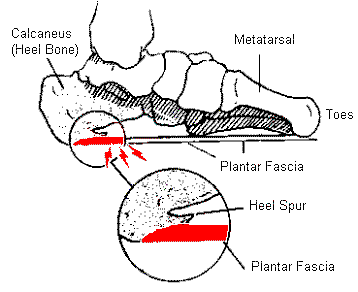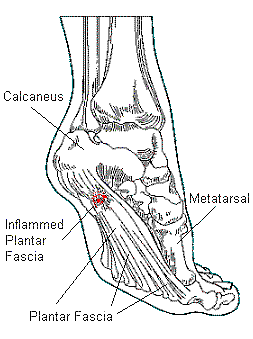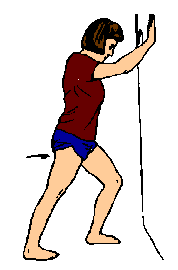
Plantar Fasciitis
Anatomy & Function
The plantar fascia is a thick, broad, inelastic
band of fibrous tissue that courses along the bottom (plantar surface) of the
foot. It is attached to the heel bone (calcaneus) and fans out to attach to the
bottom of the metatarsal bones in the region of the ball of the foot. Because
the normal foot has an arch, this tight band of tissue (plantar fascia) is at
the base of the arch. In this position, the plantar fascia acts like a bowstring
to maintain the arch of the foot.

Figure
1: Lateral (Side) View of Foot
Plantar fasciitis refers to an inflammation of
the plantar fascia. The inflammation in the tissue is the result of some type of
injury to the plantar fascia. Typically, plantar fasciitis results from repeated
trauma to the tissue where it attaches to the calcaneus.

Figure 2: Plantar (Bottom) View
of Foot
This repeated trauma often results in
microscopic tearing of the plantar fascia at or near the point of attachment of
the tissue to the calcaneus. The result of the damage and inflammation is pain.
If there is significant injury to the plantar
fascia, the inflammatory reaction of the heel bone may produce spike-like
projections of new bone called heel spurs. The spurs are not the cause of the
initial pain of plantar fasciitis, they are the result of the problem. Most heel
spurs are painless. Occasionally, they are associated with pain and discomfort
and require medical treatment or even surgical removal
Plantar fasciitis (heel-spur syndrome) is a
common problem among people active in sports, especially runners. It typically
starts as a dull, intermittent pain in the heel and may progress to sharp,
constant pain. Often, it is usually worse in the morning or after sitting, and
then decreases as the patient begins to walk around. In addition, the pain
usually increases after standing or walking for long periods of time, and at the
beginning of a sporting activity.
Often people who develop plantar fasciitis have several risk factors for doing so. They include:
Flat feet
High arched, rigid feet
Increasing age and family tendency
Running on toes, hills or very soft surfaces (sand)
Poor arch support in shoes
Rapid change in activity level
TREATMENT
Fortunately, the majority of cases of plantar fasciitis respond favorably to non-operative treatment. However, the recovery time varies tremendously from patient to patient. While some patients may be healed after 6 weeks of treatment, others may require 6 months or longer for recovery. In addition, the methods of treatment that may work for one patient, may not be successful in another patient. Typically, the methods of treatment that are attempted include anti-inflammatory mediation, icing, stretching, activity modification, and heel inserts.

Figure 3: Heel Stretch
In addition, it is necessary to avoid the
activities that are known to aggravate the fasciitis. This includes any activity
that involves repeated impact of the heel on a hard surface, such as running.
Sometimes, cortisone injections are necessary to achieve satisfactory healing.
If the pain persists, it may be necessary to run
additional diagnostic studies to rule other, less common, causes of heel pain
such as stress fractures, nerve compression injuries, or collagen disorders of
the skin.
Rarely, surgical treatment is necessary. However, when the nonsurgical treatments have been tried and they have failed, surgery may be indicated for the relief of heel pain. Most of these surgical procedures can be completed on an outpatient basis in less than one hour. The surgery can be accomplished under local anesthesia or minimal sedation administrated by a trained anesthesiologist.
Surgical treatment options include:
Surgical removal/release of the fascia. A small incision is made on the inside of the heel and the inflamed tissue is removed or released.
Removal of bone spurs. During the same operation that is used to separate the connective tissue from the heel bone, the offending heel spur can be removed.
POSTOPERATIVE CARE
Immediately after either operation, a cast may
or may not be used to support and immobilize the foot for two or three weeks.
Crutches may be helpful for greater comfort and mobility while the foot heals.
When the cast has been removed, three to four
weeks of physical therapy will speed healing and reduce swelling.